
Do you have a question about the Toshiba 42XL700T and is the answer not in the manual?
Welcome message for the Toshiba LCD Colour TV and guidance on using the manual.
Crucial guidelines for safe operation and installation of the TV.
Safety guidelines for power connection, stable placement, and ventilation.
Safety guidelines for moving the TV and installing an outdoor aerial system.
Safety precautions for using the TV in environments like high humidity or near heat sources.
Warnings regarding electric shock, cord handling, and damage prevention.
Guidelines on self-repair, handling malfunctions, and contacting service technicians.
Procedures for safely cleaning the TV and its components.
Advice on protecting the LCD screen and understanding potential anomalies.
Information on interference and using the TV in low temperatures.
Details on Dolby, DivX, HDMI, Audyssey, DLNA, and MPEG technologies used.
Guide on connecting an outdoor aerial for optimal reception.
Initial setup steps like installing remote control batteries and exploring TV features.
Overview of physical buttons on the TV for operation.
Detailed explanation of buttons on the remote control and their functions.
Diagram and explanation of all input/output terminals on the TV's rear.
Explanation of remote control buttons for TV and Media Player functions.
Explanation of remote control functions specific to REGZA-LINK mode.
Instructions for powering the TV on and switching it to standby mode.
Guide for initial setup including language selection and auto-tuning.
How to access and use the Quick Menu for fast setting adjustments.
How to navigate and use the TV's on-screen menu system.
Guide to selecting menu language and changing channel positions.
How to quickly switch between two viewing positions.
Steps for auto-tuning and manual tuning of TV channels.
Detailed options for manual channel tuning like signal class and labeling.
How to move and store TV channels to preferred positions.
Choosing between Home and Store modes for TV display settings.
General notes on picture controls and availability.
How to choose different aspect ratios for viewing content.
Adjusting the horizontal and vertical position of the picture.
Restoring picture position settings to factory defaults.
Selecting preset picture styles like Dynamic or Store.
Restoring Picture Mode settings to factory defaults.
Customizing settings like Backlight, Contrast, and Sharpness.
Adjusting the black/white level to improve dark area definition.
Improving motion smoothness for cinematic content.
Adjusting the warmth or coolness of the picture tint.
Reducing grainy noise in MPEG signals for clearer pictures.
Fine-tuning picture colour quality using base colour adjustments.
Automatically adjusting screen brightness based on ambient light.
Optimizing backlighting levels to suit ambient light conditions.
Adjusting the levels of black in the picture for better detail.
Adjusting picture clarity levels for desired settings.
Individually turning colours (Red, Green, Blue) on/off for accurate adjustment.
Displaying brightness histogram and control curve for scenes.
General notes on sound settings.
Using Auto, Mono, Dual 1, and Dual 2 modes for TV sound.
Selecting Stereo, Mono, or Dual audio for broadcasts.
Setting the balance between left and right audio channels.
Customizing sound modes based on TV installation (Stand/Wall).
Configuring sound output when headphones are connected.
Controlling audio compression for digital TV programs.
Configuring output for Dolby Digital or PCM audio.
Scheduling the TV to turn on automatically at a preset time.
Setting the TV to turn off automatically after a selected period.
Configuring Auto Power Down and No Signal Power Down features.
Activating Blue Screen and 4:3 Stretch for display customization.
Disabling TV buttons while allowing remote control use.
Restoring all TV settings to original factory values.
Displaying licensing information for the TV's software.
Checking the current software version installed on the TV.
Choosing which input source to view on the TV screen.
Selecting the appropriate colour system (PAL, SECAM, NTSC).
Making input selection more convenient by skipping unused inputs.
Assigning custom names to connected video input devices.
Displaying and selecting channels from the channel list.
Connecting and controlling REGZA-LINK compatible devices.
Configuring and managing REGZA-LINK features like Auto Power and Standby.
Automatic adjustment of settings when connecting a compatible Toshiba PC.
Setting up teletext language and mode preferences.
Choosing between Auto and List modes for teletext viewing.
How to use the TEXT button and understand teletext display.
Selecting subtitle language or turning subtitles on/off.
Navigating teletext pages, sub-pages, and using FASTEXT.
Displaying the broadcaster's time on the teletext screen.
Connecting auxiliary equipment to the TV's side terminals.
Connecting equipment to the TV's rear terminals.
Connecting an external woofer to the TV's woofer output.
Enhancing sound quality by connecting to an audio system.
Connecting an amplifier with a Dolby Digital decoder.
Connecting an amplifier with a digital optical audio input.
Connecting HDMI and DVI devices for digital video and audio.
Details on connecting HDMI/DVI devices and supported formats.
Connecting an AV amplifier to the TV using an HDMI cable for audio.
Connecting an HDMI device via HDMI cable for video and audio.
Connecting a DVI device using an HDMI-to-DVI adapter cable.
Choosing PC or HDMI 3 audio mode for the PC/HDMI 3 input.
Selecting Auto, Digital, or Analogue audio modes for HDMI 3.
Configuring Content Type, INSTAPORT™, and RGB Range for HDMI.
Adjusting RGB signal range for optimal picture display.
Connecting a PC to the TV via RGB/PC or HDMI terminals.
Adjusting picture position, clock phase, and sampling clock for PC input.
Restoring PC settings to factory defaults.
Connecting and controlling REGZA-LINK compatible devices.
Connecting the TV to a home network for DLNA access.
Configuring network settings for automatic or manual IP address setup.
Setting up Auto or Manual IP address configuration.
Viewing the TV's fixed MAC address.
Entering text using the on-screen software keyboard.
Changing the TV's device name for Media Renderer.
Setting a password for DMC access to web pages on the DMR.
Limiting which DMCs can control the TV.
Setting the maximum volume for DMC operation commands.
Overview of playing media files from USB/SD card or network.
Configuring the Media Player to start automatically on device insertion.
Exiting the Media Player application.
Playing media files from a DLNA CERTIFIED Server.
Browsing photos in Multi View, Single View, and Slide Show modes.
Organizing photo files by name, newness, or oldness.
Organizing DLNA files by title, new, or old.
Selecting and playing movie files from a list.
Choosing preferred subtitle and audio tracks for media playback.
Configuring playback repeat options (Off, All, 1) for media files.
Registering the TV for DivX Video-On-Demand services.
Information about DivX video format and Video-On-Demand services.
Exiting the movie playback interface.
Listening to music files from USB devices or DLNA servers.
Showing status information for DLNA files during playback.
Using the TV as a digital picture frame.
Configuring photo selection, editing, and auto power-off for the photo frame.
Setting an automatic power-off timer for the active photo frame.
Solutions for common TV symptoms like no picture, no sound, or poor reception.
Explanations for screen issues like dead pixels or varying brightness.
Tips for remote control and REGZA-LINK operation problems.
Table listing OSD channel numbers and corresponding RF frequencies.
Details on broadcast transmission systems by country and region.
Technical specifications including model, power, dimensions, and mass.
Information on RF signals, component video inputs, and aspect ratio.
Detailed list of terminals, audio power, speakers, and operating conditions.

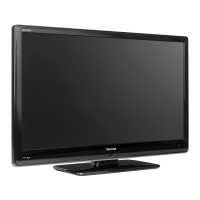
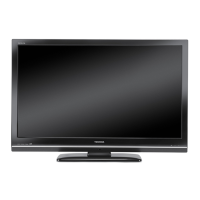
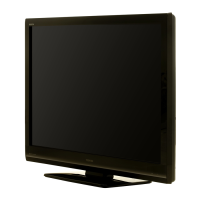
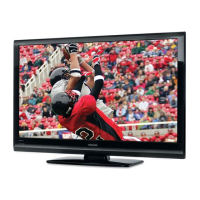
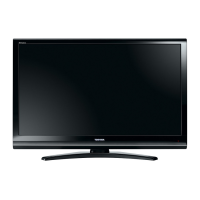
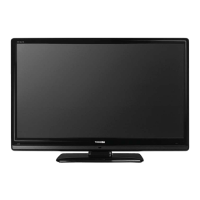


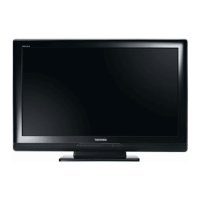


